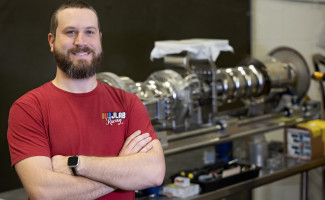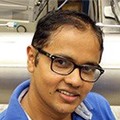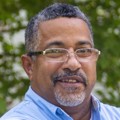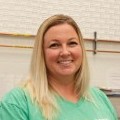Mike Murphy’s laws for making things go right
Mike Murphy has his own set of laws to make sure his projects have maximum impact. Whether he is layering 50 sheets of Mylar onto a niobium cryomodule cavity or using his weekends to build a high-performance race car, Murphy abides by a personal code that calls for him to seek challenging build projects that require a commitment to precision and attention to detail.
At Jefferson Lab, Murphy works in the superconducting radiofrequency (SRF) group to assemble more than 1,000 separate components into a single cryomodule. Each cryomodule can connect to dozens of other cryomodules to create a path for a particle accelerator.
More than 50 cryomodules have been built and tested for the Continuous Electron Beam Accelerator Facility (CEBAF), which is Jefferson Lab’s main particle accelerator and a U.S. Department of Energy user facility for nuclear physics research. CEBAF cryomodules are about three feet across and 30 feet long and weigh about 12,000 pounds each.
Murphy’s group also assembles cryomodules for other particle accelerator facilities, including nearly two dozen units for the Spallation Neutron Source at DOE’s Oak Ridge National Laboratory. They are also currently assembling cryomodules for the Linac Coherent Light Source at SLAC National Accelerator Laboratory at Stanford University.
“For SLAC, each cryomodule is 43 feet long and is made up of eight total cavities that contain nine cells per cavity,” Murphy describes.
The process of assembling each cryomodule takes months. In order to attain the best possible conditions for a build, Murphy likes to understand the functionality and purpose of each piece of the equipment he is assembling.
Under the hood and behind the wheel
Murphy says this attention to the inner workings of intricate systems has served him well outside of the lab, as well. As a car enthusiast—both under the hood and behind the wheel—Murphy takes joy in fine-tuning his machines part-by-part. During his senior year of high school, Murphy participated in a school-sponsored mentorship at Custom Car Care, an auto repair/performance shop he admired.
“I picked this shop specifically, because it's one of the top performance shops in the state. People would come from all over to get their cars worked on by the guys at Custom Car Care and tuned by Brady—the owner—because he was the master at getting every bit of power out of an engine,” he recalls.
Later, as a young adult, the shop owner, Brady, offered him a job.
“I was supposed to be filling in for someone temporarily, but I ended up working in the shop for more than seven years,” Murphy says.
During the time Murphy was refining his mastery of engines at the repair shop, Brady took him on his first spin around a race track.
“I had always loved cars and racing, so when I had the chance to ride along with Brady on the racetrack—and then try it out for myself in a shop car during a weekend event—I was hooked,” he remembers. “My first track event was on my 22nd birthday, the next week I bought my first car and got to work building it up.”
As a driver, Murphy competed at Langley Speedway, winning a handful of plaques for group wins and time trials. He has also taken High Performance Driving Education (HPDE) classes at Virginia International Raceway in Danville, Virginia.
Engines and cryomodules as “powerplants”
When a friend who worked at Jefferson Lab suggested Murphy apply for a position as a lab technician, which required similar skills to those that Murphy had developed at the shop, he decided to embark on a career change.
“The skills I learned from building my car help me with the precision work and attention-to-detail that the cryomodules and car engines have in common,” Murphy explains. “In the end, they are both ‘powerplants,’ and work starts from the inside and goes outwards, adding parts to make them better, faster and stronger.
“Like an engine, assembling cryomodules requires an enormous level of accuracy and competence when it comes to the critical sensitivity of the pieces we work with,” he says.
Murphy appreciates that his work requires him to stay active and focused.
“Working at the lab allows me to keep my mind sharp,” he says. “Being the minor perfectionist that I am, I have to keep sharp so I can be proficient in a lot of stages in the assembly process to make sure everything is accurate and put together correctly.”
Murphy’s law for himself moving forward: keep enjoying the work.
“Jefferson Lab is the last place I’m going to work,” he adds. “I don’t see myself leaving. The people are great. It’s laid back, but it’s challenging. It’s everything you’d want for a career.”
Learn more
Superconducting Radiofrequency Group
SLAC National Accelerator Laboratory at Stanford University
By Carrie Rogers









































